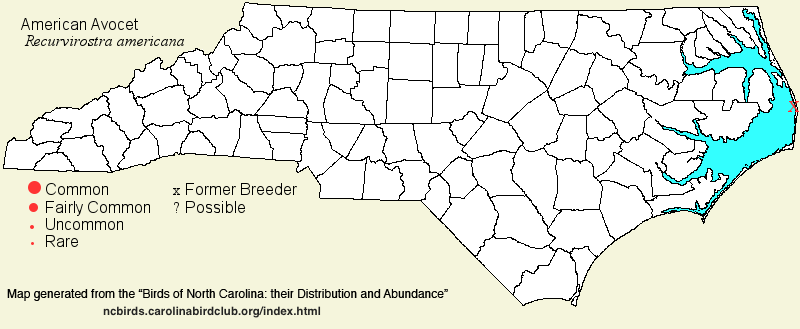 |  |
|
American Avocet - Recurvirostra americana RECURVIROSTRIDAE Members: | Search Common: Search Scientific: |
|
|
|||||||
| General Comments | Over most of the world, various species of stilts (genus Himantopus) and avocets (genus Recurvirostra) occupy the same bodies of water, often a single species of each genus per continent. In North America, the Black-necked Stilt and its "cousin", the American Avocet, breed at many of the same lakes and ponds in the western half of the continent; however, the avocet does not nest in eastern North America (unlike the stilt), though a pair did actually nest once in North Carolina! Like the stilt, the American Avocet is intensely local in its occurrence in this state, with the great majority of birds staying in the Pea/Bodie islands area nearly all year; it can be difficult to find the species anywhere else. Avocets feed in tight flocks in shallow waters of brackish to fresh ponds and pools, mostly at impoundments; they avoid tidal water. Unlike the stilt, which is seldom found inland, avocets do put down in migration inland, at least on rare occasions, often in flocks up to 10-13 birds. | ||||||
| Breeding Status | Accidental Breeder | ||||||
| NC BRC List | Definitive | ||||||
| State Status | |||||||
| U.S. Status | |||||||
| State Rank | S1N | ||||||
| Global Rank | G5 | ||||||
| Coastal Plain | Winter resident and migrant, coastally; accidental breeder, along the coast. Fairly common to common in the Bodie/Pea Island area from Jul to spring, but less numerous in May-Jun; very rare to rare elsewhere along the coast, mainly in fall migration, very rare in winter and spring. Two one-day-old chicks were seen on 18 Jun 1968 at Pea Island [Chat 42:31-32 link]. Very rare migrant in the Tidewater zone and the inland portions, essentially only in fall (mid-Jul to mid-Nov); no winter or spring records away from coastal areas, except for a few early winter records at Lake Mattamuskeet, and one spring record from Lake Auman (Moore), a flock of 15 in Apr 1995 [Chat 60:119 link]. Peak counts: 550, Pea Island, 10 Nov 2010; 500, Pea Island, 8 Dec 2001; peak count away from Bodie/Pea islands: 200, Lake Mattamuskeet, 15 Jan 2009. | ||||||
| Piedmont | Transient. Rare fall migrant, and accidental/casual spring migrant, with most records from larger reservoirs. Mainly mid-Jul to mid-Nov; the only spring report is one at Falls Lake, 2 May 2004. Peak counts: 15, Jordan Lake (Chatham), 23 Sep 2024; 13, Lake Brandt near Greensboro, 9 Oct 1966; 13, western end of Lake James (McDowell), 10 Aug 2020; 12, Cane Creek Park (Union), 26 Jul 2016; 12, Lake Norman, 20 Oct 2012; 11, Lake Norman, 8 Aug 2015; 11, Falls Lake (Durham), 11 Aug 2015; 11, Lake Crabtree (Wake), 10 Sep 2016; 11, along Howerton Road (Guilford), 16 Oct 2016; 11, Riverbend Park (Catawba), 22 Sep 2022; 11, in flight over Salem Lake (Forsyth), 11 Jul 2023; 11, Ellerbe Creek arm of Falls Lake (Durham), 21-29 Oct 2023. These high counts suggest that avocets often migrate southward in groups of 11 to 13 birds, at a maximum! | ||||||
| Mountains | Transient. Very rare southbound migrant in summer and fall, with 13 known records: 1, Cashiers (Jackson), 3 Jul 1985; 1, Glendale Springs (Ashe), 22 Sep 1968; 5, Beaver Lake at Asheville, 21 Oct 1999; 1, Lake Junaluska (Haywood), 7 Oct 2013; 3, Lake Junaluska, 23 Nov 2014; 1, Hooper Lane (Henderson), 31 Aug 2017; an excellent 8 at the Mills River Water Treatment Plant (Henderson), 16 Jul 2018 (plus 2 seen there earlier on 14 Jul); a remarkable 23 on Lake Junaluska on 23 Oct 2019; five at Lake Julian (Buncombe), also on 23 Oct 2019; 4, Lake Louise in southeastern Alleghany on 13 Aug 2023; 1, Lake Junaluska on 18 Sep 2023; a surprising 5, Grandmother Lake (Avery), 4 Jul 2024; and 12, Hooper Lane, 26 Sep 2024. Peak count: 23, Lake Junaluska, 23 Oct 2019. | ||||||
| Finding Tips |
The only reliable spots are the impoundments at Pea Island NWR and less so at the adjacent Bodie Island lighthouse pond. At least a few birds are present there year round, though they are much more numerous in fall. Flocks over 200 avocets have been seen there, though in recent years the number has been around 50-100 birds. Though there are a few avocet reports nearly each year away from these areas, do not intentionally look for the species elsewhere. *** | ||||||
| Attribution | LeGrand[2025-01-29], LeGrand[2024-10-31], LeGrand[2024-02-10] | ||||||
| NC Map Map depicts all counties with a report (transient or resident) for the species. | Click on county for list of all known species. |
| NC Breeding Season Map Map depicts assumed breeding season abundance for the species. |  |